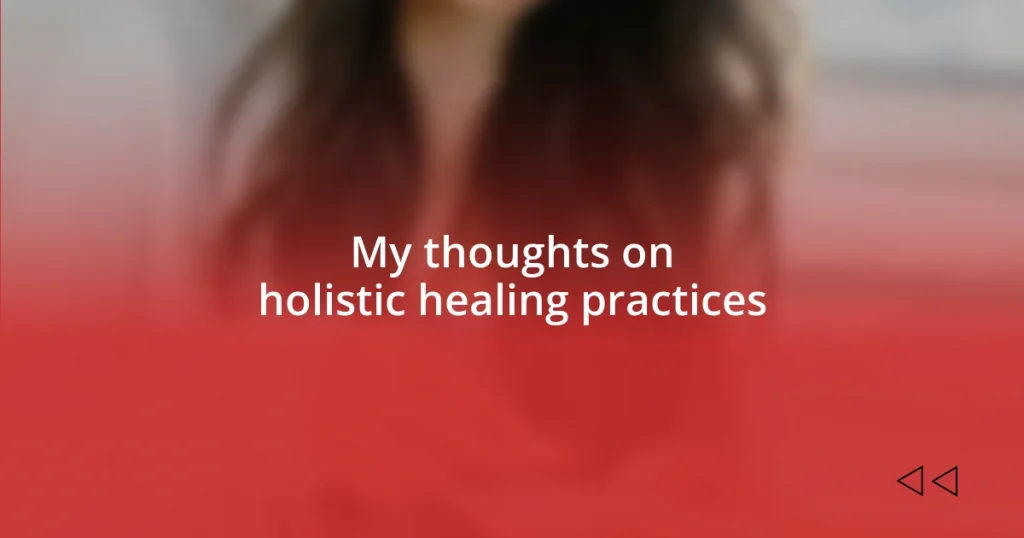Key takeaways:
- Holistic healing emphasizes treating the whole person, integrating physical, emotional, and mental well-being through practices like yoga and meditation.
- Benefits include improved emotional health, self-awareness, and a comprehensive approach to self-care through various modalities such as acupuncture and nutritional counseling.
- Challenges in holistic healing involve skepticism, time commitment, and cost considerations, which can hinder individuals from fully exploring these healing practices.

Understanding holistic healing practices
Holistic healing practices focus on treating the whole person, not just the symptoms of a disease. I remember a time when I was feeling overwhelmed by stress. Instead of just seeking medication for anxiety, I explored yoga and meditation, which really changed my perspective on health. It made me realize that my emotional well-being is just as crucial as my physical health.
What always fascinates me about holistic approaches is their emphasis on balance. Have you ever noticed how interconnected your mind and body are? When I began to pay attention to my thoughts during my workouts, I found that being mindful not only improved my physical performance but also uplifted my spirit. It felt liberating to recognize that my mental state could influence my physical health.
The integration of various therapies, such as acupuncture, aromatherapy, or nutritional counseling, adds a unique dimension to holistic healing. Personally, I had a remarkable experience with herbal teas that not only satisfied my taste buds but also supported my digestive health. Have you ever considered how a simple cup of tea could soothe your body and mind simultaneously? It’s this kind of interconnectedness that makes holistic healing truly compelling to me.

Benefits of holistic healing methods
Holistic healing methods offer several benefits that resonate deeply with me. One major advantage is the focus on emotional well-being, which can significantly impact our overall health. I recall a time when I indulged in a series of guided meditations. The experience not only calmed my mind but also uncovered hidden emotions that had been lingering beneath the surface. I felt a burden lifted, showcasing how much our emotional health can affect our physical state.
Another compelling benefit is the promotion of self-awareness and personal growth. As I delved into journaling alongside my holistic practices, I found a newfound clarity about my life goals and my emotional triggers. This awareness empowered me to make more intentional choices about my lifestyle, creating a ripple effect on my health journey. Have you ever stopped to reflect on how your choices relate to your well-being? It’s astonishing how small changes can lead to profound improvements.
Moreover, the practice of integrating various healing modalities encourages a comprehensive approach to self-care. For instance, after incorporating herbal remedies and nutrition into my wellness routine, I began noticing improvements in my energy levels. The combination of physical care and emotional nurturing allowed me to find a balance that I had never experienced before. It felt like unlocking new potential in myself, which is why I believe holistic methods are a vital aspect of personal health management.
| Benefit | Description |
|---|---|
| Emotional Well-Being | Helps address emotional issues, leading to reduced stress and anxiety through practices like meditation. |
| Self-Awareness | Encourages personal growth and reflection, fostering intentional life choices that enhance overall health. |
| Integration of Modalities | Combines various therapies, promoting a comprehensive approach that balances physical and emotional health. |

Common types of holistic therapies
Holistic therapies come in many forms, each with its unique approach and benefits. I find that these diverse practices cater to various needs, making it easier for individuals to find what resonates with them personally. For instance, I once attended a sound healing session that used vibrational frequencies to promote relaxation. The experience felt deeply restorative, as the sounds washed over me, creating an almost transcendent state.
Here are some common types of holistic therapies:
- Yoga: A mind-body practice that combines physical postures, breath control, and meditation, often helping to enhance flexibility and mental clarity.
- Acupuncture: An ancient Chinese technique that involves inserting thin needles into specific points on the body to balance energy and relieve pain.
- Aromatherapy: The use of essential oils to promote emotional and physical well-being; I love diffusing lavender at night to help me unwind after a long day.
- Nutritional Counseling: Tailoring dietary choices to meet individual health needs; I noticed a significant difference in my energy levels when I started paying attention to my food choices.
- Reiki: A form of energy healing that channels positive energy through the practitioner’s hands to promote relaxation and healing.
Diving deeper into these therapies can lead to profound personal insights. With each practice, I have discovered not only what my body needs but also what my mind and spirit crave for balance. It’s fascinating how trying something like Tai Chi introduced me to a more mindful way of moving, which I never knew I needed until I experienced its calming effect on my daily stress.

Potential challenges with holistic healing
When considering holistic healing practices, I often reflect on the potential challenges that can arise. One notable concern is the skepticism that some may hold toward these methods. I remember discussing my interest in acupuncture with a colleague who dismissed it outright as “just a placebo.” It made me realize that, for many, the unusual nature of these therapies can lead to mistrust, preventing them from fully exploring the options available to them.
Another challenge that I’ve encountered is the time commitment required for many holistic practices. For example, I initially hesitated to engage in yoga because I worried about fitting it into my busy schedule. However, once I committed to it and made it a priority, I discovered moments of peace that were well worth the investment. I often wonder, do we underestimate how much time we dedicate to our well-being? It’s about finding that elusive balance.
Cost is another hurdle that can deter people from trying holistic approaches. Some treatments, especially those provided by specialized practitioners, can be quite expensive. I encountered this firsthand when I wanted to try a series of guided meditations that came with a hefty price tag. It made me question whether the investment would yield the benefits I was seeking. In situations like this, I think it’s crucial to weigh the potential long-term gains against the initial costs. How do we value our health and well-being? Sometimes, it requires a leap of faith.















